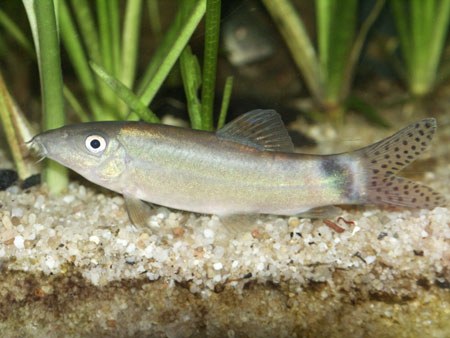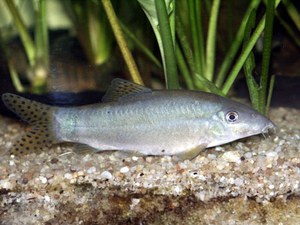Yasuhikotakia caudipunctata
Summary
Scientific Name: Yasuhikotakia caudipunctata (Kottelat, 2004)
Common name: Speckle-tailed Loach.
Synonyms: Botia caudipunctata (Taki & Doi, 1995)
Distribution: Laos, Thailand.
Sexual Dimorphism: Females generally plumper all over than males.
Maximum size: 4 inches.
Similar to: Yasuhikotakia splendida. Young may be confused with young Y. eos

Care: Needs excellent filtration and regular water-changes.
Y. caudipunctata are excellent diggers that appreciate a sand substrate to protect their delicate barbels. Territorial... needs a large aquarium with lots of hiding places and subdued lighting. Tends to be quite nocturnal.
Feeding: Good quality flake, sinking pellets, algae wafers, chopped earthworms, thawed frozen Bloodworm, Mysis Shrimp, chopped Cocktail Shrimp. Avoid over-feeding as these fish are very greedy.
Water parameters: pH:6.5-7.5. Hardness: Medium. Max dh: 12
Temperature: 78.8ºF to 86ºF(26-30°C)
Breeding: Not bred in aquaria.
Notes
 Y. caudipunctata is a seldom imported,
highly aggressive loach that should be kept in a group of their own species. Like its
cousin, Y. modesta, they have a social
structure and an "Alpha" loach will eventually lead the group. The fish are
highly territorial and a lot of in-fighting will be seen. For this reason,
provide numerous hiding places so that less dominant fish may escape the
attentions of more boisterous individuals.
Y. caudipunctata is a seldom imported,
highly aggressive loach that should be kept in a group of their own species. Like its
cousin, Y. modesta, they have a social
structure and an "Alpha" loach will eventually lead the group. The fish are
highly territorial and a lot of in-fighting will be seen. For this reason,
provide numerous hiding places so that less dominant fish may escape the
attentions of more boisterous individuals.
Because of their quite nasty temperament, Y. caudipunctata should only be kept with other boisterous loach species, or large, fast moving, free-swimming fish such as large Barb species.
Body and fin coloration can be somewhat variable in this species, probably due to the wide distribution in nature. Fins generally orange to yellow, with dorsal lightly speckled with black. Caudal is covered with small black dots, hence the name. Body colour may appear silvery to bluish, with a green or gold sheen along the back. a distinctive feature is the ill-defined dark blotch on the caudal peduncle, a golden area in front of that at the dorsal surface and in front of that a occasionally visible dark saddle marking just before the posterior of the dorsal fin. Young fish may be very attractive, but the colours fade somewhat as they mature.

Might be confused with Y. splendida. That species shares the spotted caudal, but the spots are far larger. Young look similar to Y. eos.
On the left here is a young Y. eos.
The right-hand fish is Y. caudipunctata.
Note hint of a saddle behind dorsal fin.
Photo Gallery
Click to view all images of this species! |
|
Document Actions


